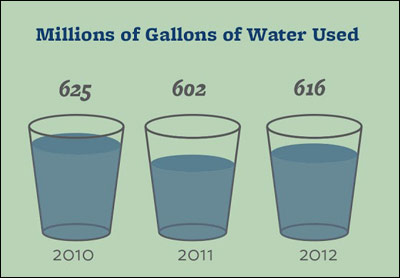Every drop counts: Taking steps to conserve water
How much water does the campus use, and what are the opportunities to conserve? Among other measures, UC Berkeley has just launched "Every Drop Counts," a campaign to raise awareness, as California’s official drought emergency enters its second month.

February 18, 2014
Water conservation was on everyone’s mind at the inaugural meeting Friday of the Berkeley Sustainability Community, a new forum for environmentally minded students, staff and faculty to meet together and share ideas.

A new poster downloadable from sustainability.berkeley.edu offers water-saving tips for home and work.
“I constantly nag my roommates: ‘Guys, we’re in a drought,’” one student said. But her harangues, together with reminder signs, have helped water-wise behaviors “become a habit,” she added. “We’re all on the same page now.”
“We need to make the default choice the sustainable choice” when designing new systems, another attendee offered.
The exchange took place as California’s official drought emergency approached the one month mark and UC Berkeley intensifies its efforts to conserve H20.
Campus research on the severity of the drought “overwhelmingly sends a clear call to action,” Chancellor Nicholas Dirks said in a Feb. 5 message to the campus community. Because domestic use – for bathrooms, showers and kitchens – accounts for 50 percent of campus water consumption, Dirks asked students, faculty and staff to use less water in their daily routines. If each member of the campus community were to save a gallon of water a day, he noted, the weekly total could be cut by 250,000 gallons.
In response, the campus is launching a campaign to raise awareness and create, or reinforce, personal water-conservation habits – habits that hopefully will apply beyond the campus and persist long after the current emergency.
“Every Drop Counts” offers information on “simple actions that can make a difference,” as Dirks put it – such as taking shorter showers and reporting leaks promptly to (510) 642-1032.

Campus water use detailed in the 2013 Sustainability Report.
An informational poster, suitable for display in student residence halls, classroom buildings and other campus facilities, is available for download from the “Saving Water Page” linked from sustainability.berkeley.edu. The website contains additional resources and tips on conserving water wherever one lives or works.
Getting water wise
In response to the drought emergency, which Gov. Jerry Brown declared on Jan. 17, the campus is also exploring opportunities for new projects to build on past water-conservation successes.
“We’ve been reducing water consumption pretty steadily since the 1990s,” Lisa McNeilly, director of sustainability, says. Water use is down 17 percent since 1990 in absolute terms, despite the growth of campus facilities in that period, she noted.
Infrastructure changes account for much of that progress. In University Hall, for instance, retrofits of tankless toilets contributed to a 17 percent reduction in water use over a year’s time. Meanwhile, in residence halls, water use has dropped by more than 35 percent per student over the past decade. According to the campus’s 2013 Sustainability Report, “this “dramatic and unexpected decline” is largely due to installation of more water-efficient technologies,” as well as educational outreach encouraging residents to conserve water.
A student-initiated campaign, “Fight the Flow,” is one of many past water-related projects funded by students through The Green Initiative Fund (TGIF). And earlier this month the ASUC Senate passed a bill encouraging additional efforts to reduce the campus’s “water footprint.”

UC Berkeley campus water usage (Source: 2013 Sustainability Report)
McNeilly says the campus is now more than halfway to the goal of 10 percent water-use reduction by 2020 (against 2008 levels) set by then-Chancellor Robert Birgeneau in 2011, when water reservoirs were full. So far, water use is down 6 percent, she says.
(In mid-January UC President Janet Napolitano announced another target, a 20 percent per-capita reduction by 2020 across the UC system. That goal is pegged to each campus’s water-usage baseline, which Berkeley set as the three-year average for 2003-5. The campus has already met that goal, McNeilly says.)
Landscape measures
Campus landscape and grounds staff met the last week of January to discuss possible measures to further reduce water used for irrigation, which currently accounts for roughly 8 per cent of the campus total. Suggestions ranged from repairing leaks to converting selected lawns to mulch or to woody or herbaceous plants.
“We’ve converted more than 80,000 square feet of lawn, since 2006, either to no-mow turf, mulch or other uses,” says campus landscape architect Jim Horner. “As we design new projects, we’re being more water wise.” (See a PDF listing recent campus turf-conversion projects here).

(Source: East Bay MUD)
Due to infrastructure upgrades over the past 15 years, 98 percent of central-campus irrigation systems are now automated and connected to weather stations, which monitor campus microclimates and can override or adjust watering schedules.
The campus continues to install high-efficiency, low-precipitation spray heads, replace spray with more drip irrigation, and install additional flow meters,” Horner says. The latter can detect leaks and shut down the system when maximum flows are exceeded.
The campus is also planting more drought-tolerant plant species and replenishing wood-chip mulch, he adds. “The deeper into the drought we go, the more evident our water-management practices will be. Some lawns may be allowed to go dormant. Recirculating fountains will be shut off and wash-downs of pavement, which use well water, may stop.”
Related information:
- EBMUD’s Water Smart Center includes free water-conservation items, such as low-flow shower heads and residential services and rebates.